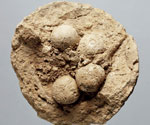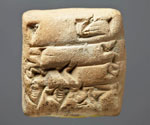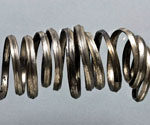Commerce and Coins in the Ancient Near East
A Mini-Exhibit at the Oriental Institute Museum, August 11- October 30, 2011
Commerce and Coins in the Ancient Near East, a mini-exhibit at the Oriental Institute Museum, looks at commerce and trade from 3000 BC to the 4th century BC. The exhibit is presented in conjunction with the American Numismatic Association's World's Fair of Money being held in Chicago August 16 - 20th, 2011. The exhibit will be on view from August 11 to October 30 (extended from original time period).
Commerce, trade, and early forms of currency can be documented for thousands of years before the first coins were minted in southwestern Turkey in the 7th century BC. Exchanges of goods and services before that time were tracked by detailed receipts and notations that took many forms. Among the earliest are represented in the show by clay balls that contain small tokens that represented numbers and commodities. Once the delivery was made, the ball was broken open to verify that the amount of goods matched the tokens in the ball. Among the other receipts in the show is one for salt written in ancient Egyptian on a flake of pottery, and another for the delivery of a dead sheep written in wedge-shaped cuneiform script on a clay tablet. A third tablet, dating to about 2000 BC, is a request for money to purchase a female slave.


Egyptian and Mesopotamian weights and measures document the standardization of trade in early barter economies. In Mesopotamia, the adoption of a silver standard that equated measures of barley with a set amount of silver is illustrated by a rare example of a spiral coil of silver, lengths of which were snipped off to pay debts. Among the early coins is a silver stater probably of king Croesus (570-547 BC) of Lydia (southwestern Turkey) that was excavated by the Oriental Institute at Persepolis in southwest Iran. Other examples of very early coins from Egypt include a gold stater of Ptolemy I (305 BC), and coin molds that show how Roman coins were made — and forged.

The Oriental Institute is an interdisciplinary institute at the University of Chicago, focused on the study of the languages, history, archaeology and cultures of the ancient Near East. The Museum of the Oriental Institute has galleries devoted to Mesopotamia, Assyria, Anatolia, Palestine/Israel, Egypt, Nubia and Persia. "Before the Pyramids: The Origins of Egyptian Civilization" is on view through December 31.
The Museum is open Tuesday, Thursday through Saturday from 10 a.m. to 6:00 p.m., Wednesday from 10:00 a.m. to 8:30 p.m., and Sunday from noon to 6:00 p.m. The museum is closed on Mondays and major holidays. Admission is free, although a donation of $7 for adults, $4 for children is appreciated.
The Oriental Institute Museum is located on the campus of the University of Chicago, approximately 20 minutes south of the Loop at 1155 East 58th Street.
For further information, on the web: oi.uchicago.edu, or call 773 702 9514.

